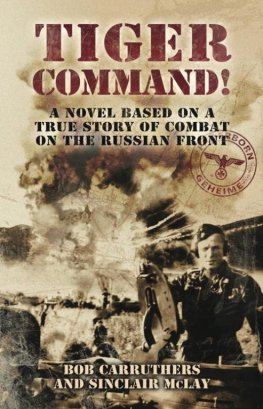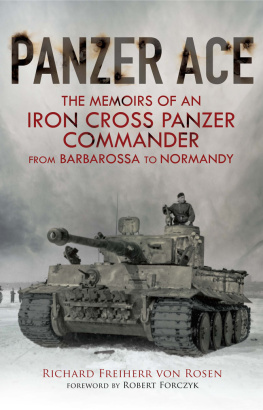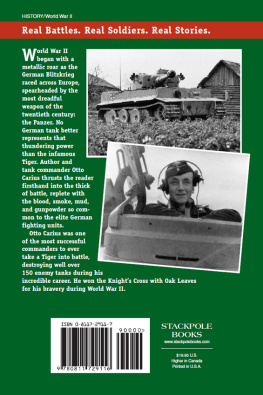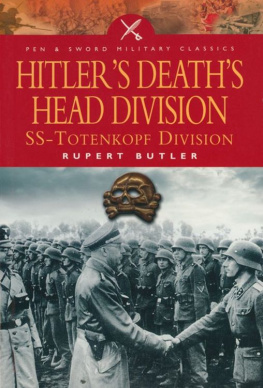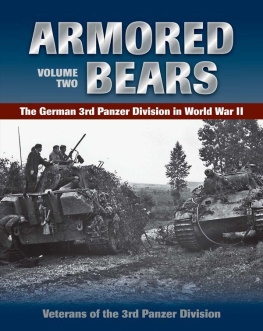Copyright 2013 by Ian Michael Wood
Published by
STACKPOLE BOOKS
5067 Ritter Road
Mechanicsburg, PA 17055
www.stackpolebooks.com
All rights reserved, including the right to reproduce this book or portions thereof in any form or by any means, electronic or mechanical, including photocopying, recording, or by any information storage and retrieval system, without permission in writing from the publisher. All inquiries should be addressed to Stackpole Books.
Printed in the United States of America
10 9 8 7 6 5 4 3 2 1
Library of Congress Cataloging-in-Publication Data
Wood, Ian Michael.
Tigers of the deaths head : SS Totenkopf Divisions Tiger Company / Ian Michael Wood.
pages cm.
Includes bibliographical references.
ISBN 978-0-8117-1313-9
eISBN 978-0-8117-5343-2
1. Waffen-SS. Panzer-Division Totenkopf, 3. Panzer Kompanie, 4 (s). 2. World War, 19391945Regimental historiesGermany. 3. World War, 19391945Tank warfare. 4. Tiger (Tank)History. 5. World War, 19391945CampaignsEastern Front. I. Title.
D757.85.W58 2013
2013033742 940.54'1343dc23
CONTENTS
INTRODUCTION
S S-Panzer-Regiment 3s 9. Kompanie had an operational life of just over two years, fighting mainly on the Eastern Front and ending World War II in Perg, Austria, on 8 May 1945. The companys personnel then spent a number of years in American or Russian confinement; only a handful managed to escape and make it home.
During the 1950s the Russians started releasing captured German military personnel and allowed them to return home. In 1959 the first veterans meeting took place, and former 9. Kompanie soldiers spent many hours recounting their experiences. It was from this first meeting that Wolfgang Barth gathered and recorded individual reports and learned the fate of other company members. Barth permitted me to use this huge collection of records as the basis for this book. Other veterans gave me their time for interviews or questionnaires, allowing me to assemble a more coherent picture of the events during MarchApril 1945. Between 2010 and 2013 I visited the battlegrounds in Poland, Hungary, and Austria, where I found many old people who still remembered their own wartime experiences.
Many of the photographs in this book will already be known to the reader, but there are new ones which have never been published before, along with new details on the former soldiers and officers of 9. Kompanie. These provide insight into the operational and working life of the unit during World War II. This book is my contribution to the ever-growing field of knowledge of the Panzerwaffe from World War II and is meant for novice and aficionado alike. Any mistakes are mine alone.
CHAPTER 1
In the Beginning
T he SS-Totenkopf-Division was the first Waffen-SS division to have tanks in its inventory. In November 1939, SS-Aufklrungs-Abteilung Totenkopf, the divisions reconnaissance detachment, did not possess a Panzersphwagen (armored car reconnaissance) company, and like the rest of the Totenkopf, it was deficient in heavy equipment. SS-Gruppenfhrer Theodor Eicke, the divisions commander, used all of his contacts across Germany to try to find any depots that had surplus equipment he could use for his division. In November 1939, he was informed that the Skoda Works in Pilsen (considered property of the Wehrmacht during this period) had a surplus of heavy artillery guns, prime movers, and tanks. Eicke had for some time been trying to get authorization to form a schwere Artillerie-Abteilung (heavy artillery detachment) for SS-Artillerie-Regiment Totenkopf, and when he did manage to get authorization, the Wehrmacht refused to supply the much-needed heavy guns. Eicke did manage to get his hands on some of the Skoda tanks.
On 20 November 1939, the divisional command issued an order creating a Panzerkraftwagen Zug (armored vehicle platoon) for SS-Aufklrungs-Abteilung Totenkopf under the leadership of SS-Obersturmfhrer Hardieck, who commanded the Kradschtzen (motorcycle) company. Initially, the platoon was to contain three Pz.Kpfw. 35(t) or 38(t) in order to fill in the gap that resulted from the shortage of Panzersphwagen. On the twenty-second, SS-Obersturmfhrer Hardieck took command of the new formation. The crews were provided by SS-Infanterie-Regiment 2. The Panzerkraftwagen platoon was under the leadership of SS-Oberscharfhrer Werkmeister (who would later serve in the Panzer regiment). The personnel drove to Pilsen on the twenty-seventh, returned to Germany during mid-December 1939, and were quartered at Burgholz. On 20 December, second and third platoons were added and organized into three sections consisting of two Panzers each, giving a total strength of six Panzers. The second section was commanded by SS-Untersturmfhrer Zimmermann, the third by SS-Untersturmfhrer Rohde.
The Panzerkraftwagen platoon spent the winter of 193940 based in Heilbronn. It first saw action on 21 May 1940 during the campaign in France, near Marcatel, while supporting SS-Infanterie-Regiment 3. The six Panzers had the following call signs: Lwe, Tiger, Panther, Geier, Sperber, and Habicht. During the fighting, the Panzerkraftwagen platoon knocked out three British tanks, but the Panzer of SS-Oberscharfhrer Werkmeister was knocked out near Arras, along with Sperber and Habicht. The platoon suffered four wounded: SS-Rottenfhrer Lamp, SS-Sturmmann Unger, SS-Rottenfhrer Theissig, and SS-Rottenfhrer Koppl. In fact, during the course of the day, the platoon suffered five total losses in Panzers, with only one Pz.Kpfw. 10(t) remaining on strength.
On 23 May 1940, the platoon took over six French tanks (three Hotchkiss H38s and three Souma S35s), which had been captured in Choques by SS-Infanterie-Regiment 3. At this time, the three section commanders were SS-Untersturmfhrer Zimmermann, SS-Scharfhrer Spuhler, and SS-Unterscharfhrer Mark. On the twenty-seventh, the platoon, with seven Panzers, advanced along the HingesLe Cornet Malo road at 0300 hours and provided support to SS-Infanterie-Regiment 3 during the assault on the La-Basse Canal. The remaining Pz.Kpfw. 10(t) was knocked out in Le Cornet Malo. The days fighting resulted in three killed and four badly wounded, including the platoon commander, SS-Obersturmfhrer Hardieck. The wounded were evacuated along with the wounded infantrymen. On the twenty-ninth, the platoon lost five of its French tanks in the area of Estaines, with only one Hotchkiss H38 tank surviving. This tank remained in service with the Totenkopf up to July 1943. The establishment of a Panzersphkompanie was ordered on 3 May 1941, with the issue of eight Panzersphwagen.
SS-Sturmgeschtze-Batterie Totenkopf
The battery was formed on 1 June 1941. Gun commanders, gunners, loaders, and radio operators were all sent from the SS-Artillerie-Ausbildungsund-Ersatz-Regiment (artillery replacement regiment) in Munich to Berlin and quartered at the Lichterfelde Barracks. Here SS-Hauptsturmfhrer Toni Laackmann assumed command of the new Sturmgeschtze Batterie. Prior to taking command of the battery, Laackmann had been 11. Kompanie commander in SS-Infanterie-Regiment 3









